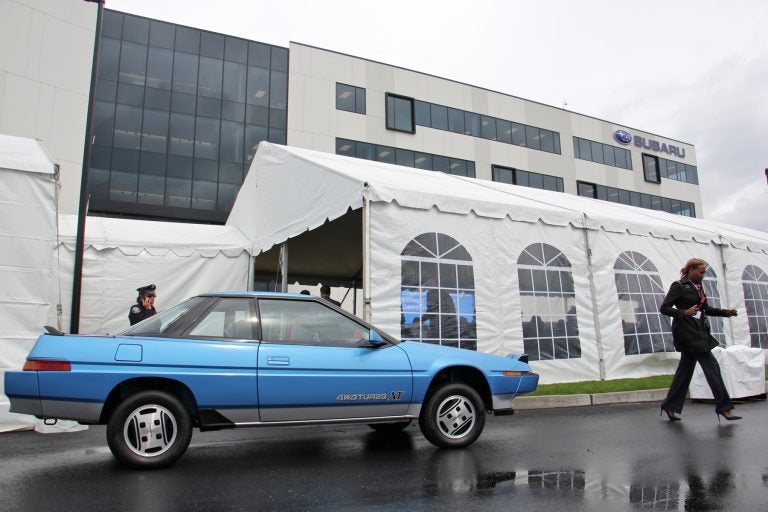N.J. tax incentive program under review – high cost of Camden jobs noted
State should reform how it gives job-creation tax incentives to businesses, suggests new report that underscores high price tag for Camden jobs
Listen 4:44
Subaru of America rolls out vintage cars to celebrate the grand opening of its headquarters in Camden. (Emma Lee/WHYY)
A long-awaited analysis of New Jersey’s controversial economic-development tax-incentive programs was just made public yesterday, and it recommends a series of changes related to cost concerns. They include streamlining bonus policies that companies can use to get more generous tax breaks and revising special rules that encourage economic development in hard-hit Camden.
The analysis, compiled by Rutgers University’s Bloustein School of Planning and Public Policy, also suggests other changes to help the state better achieve policy goals like boosting interest in clean-energy projects and new-business incubators.
The release of the report comes nearly five years after the state significantly overhauled its approach to economic development to boost job growth, which had been stalled in the wake of the Great Recession. Those changes included allowing companies and developers to get more generous tax incentives, while also reducing their requirements for investment and job creation.
But those new rules have been hotly debated since they were enacted in 2013, with critics raising the cost of the incentives as a primary concern. The new Rutgers analysis estimates the average annual per-job cost for the state’s popular Grow NJ program has been $7,650 for a new job created, and $3,670 for jobs retained using the state incentives. But those estimates don’t count projects in Camden, which is treated as an outlier in the analysis because the 2013 law made the city a top-priority economic-development zone with its own set of rules. The annual per-job average for Camden is $34,000, counting both new and retained jobs, according to the analysis.
Both the Grow NJ program and its counterpart ERG, which stands for Economic Redevelopment and Growth, provide companies and developers with tax incentives only if they meet certain goals and live up to established standards, meaning they do not receive a blank check from the state. But also fueling some of the debate over the tax incentives has been the overall slow pace of job growth in New Jersey compared to prior recoveries — despite the awarding of some $5.4 billion in state tax breaks since 2013.
Murphy critical
The new analysis of the incentive programs comes out as Gov. Phil Murphy, a Democrat, is awaiting the results of a comprehensive audit of the programs, which are soon up for renewal. It’s widely expected that Murphy — who has loudly criticized the way the incentive programs were administered during the tenure of his Republican predecessor, Chris Christie — will want lawmakers to make a new round of changes, reflecting his policy goals.
A letter submitted to Murphy along with a copy of the analysis yesterday by Tim Sullivan, chief executive officer of the state Economic Development Authority, noted the state economy has improved since the incentive programs were overhauled in 2013, something he said provides an “opportunity to reexamine award parameters.”
The Grow NJ program is specifically geared toward helping the state either lure new companies to locate here or to keep businesses that are already in New Jersey from leaving. The ERG program is designed to stimulate new development or redevelopment projects, both commercial and residential, by providing help with financing.
According to the new Rutgers analysis, 224 companies have been awarded Grow NJ tax credits by the EDA since late 2013, with the total cost estimated at $4.4 billion. The analysis tallies the per-job cost of the tax breaks at $7,650 for new jobs, and $3,670 for retained jobs, and the authors point out those figures are generally on the high end of national benchmarks if you don’t count tax breaks that were used to lure companies to or keep them in Camden.
Big bill for Camden jobs
The authors also make it clear that most of the projects they evaluated have yet to fully satisfy all the requirements that must be met to redeem their tax breaks, meaning a full evaluation of the overall benefit to the state has yet to be done. Still, they recommend changes to bonuses that companies can get for meeting some policy goals, such as building in urban areas or transit zones, suggesting there are “redundancies” in the tax-incentive programs that should be addressed. The per-job cost of tax breaks awarded to companies in Camden was also an issue raised in the analysis.
“If expenditures on a per-job basis are a concern, there may be approaches that would more closely tie awards to the same job creation/retention criteria used for other projects, while still encouraging large-scale capital investment in Camden or elsewhere,” according to the analysis.
The authors also recommend technical changes to the formulas used to assess how much a proposed project will boost the state economy. For the ERG program, which accounted for nearly 50 commercial and residential projects and about $1 billion in incentives since early 2014, the analysis recommends the EDA consider using “additional metrics” to evaluate a commercial project’s overall viability and benefits.
“It is not always clear that such projects would not have been pursued elsewhere in the state in the absence of the ERG grant, and the state benefits therefore may not necessarily constitute a net return to the state,” according to the analysis.
$25M for Rutgers athletic facilities
On the residential side, the authors suggest making changes that would expand the places where developments could qualify for incentives, and it flags as questionable the use of some $25 million in residential credits on athletic facilities by Rutgers under the existing rules.
“Future programs should seek to clearly delineate and evaluate projects by type,” the analysis said.
The analysis was required to be prepared and submitted to Murphy and lawmakers under the 2013 law that also dictated the overhaul of the incentive programs themselves. Sullivan, the EDA chief, highlighted in his letter to Murphy yesterday other issues related to the incentives, beyond what the law set as parameters for the Rutgers analysis, that should be looked at.
He recommended there be a “deeper analysis of the types and quality of jobs created or retained, and whether some or all of the related economic activity would have happened with lower or no incentives.” He also called for a “comprehensive best practices review, assessing incentive programs available in other states” in the letter to Murphy, who appointed Sullivan to lead the EDA earlier this year.
“We are not only facing a different economy than we were in 2013 when the Economic Opportunity Act was signed into law, but we are also collectively as a state focused on building a stronger and fairer economy, and that presents a real opportunity to better align our incentives with the state’s overarching economic development strategy,” Sullivan said in a statement.
_________________________________
NJ Spotlight, an independent online news service on issues critical to New Jersey, makes its in-depth reporting available to WHYY.
WHYY is your source for fact-based, in-depth journalism and information. As a nonprofit organization, we rely on financial support from readers like you. Please give today.




